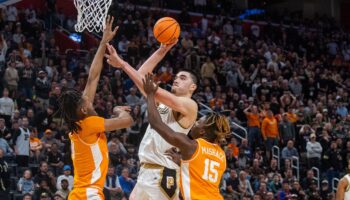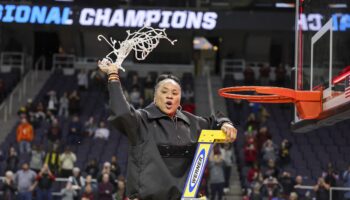
The field of 68 for the NCAA Tournament has been unveiled, and the yearly ritual of immediate backlash about the bracket and (and endless) conjecture about who will advance begins in earnest! And who are we to be above such behavior?
With that, we make our five (very) early observations about the 2014 NCAA Tournament.
1. How are San Diego State and New Mexico separated by three seed lines?
One (San Diego State) won the Mountain West regular season championship by a single game. The team they edged for that title (New Mexico) won the conference tournament title game over the former and won two out of their three match-ups this season. I understand receiving extra credit for winning the race for a conference regular season title than the sprint for winning a conference tournament, and I agree with that philosophy most times. But with both teams having the same number of wins against RPI Top 50 teams (three), New Mexico having a slightly higher RPI ranking (No. 14) than the Aztecs (No. 16) and the Lobos having a superior strength of schedule (No. 42 to SDSU’s No. 87), seeding the Aztecs a No. 4 (West Region) and New Mexico a No. 7 (South Region) defies all sorts of logic. Although, at this time last year, I was campaigning for the Lobos to receive at least a No. 2 seed by virtue of having the most Top 100 RPI wins (19) and having the No. 2 strength of schedule in the country, only for the Lobos to get a three seed – and take a serious header in their second round against Harvard. So I guess I should shut my mouth about the Lobos until further notice.
2. Beware the No. 4 seeds!
The Pac-12 Tournament champions (UCLA), the Mountain West regular season champions (San Diego State) and two teams playing like No. 1 seeds (Louisville, Michigan State) make up the four No. 4 seeds in the NCAA Tournament. That might be the most dangerous make-up of No. 4 seeds in any NCAA Tournament in the 64-team era. To boot, at least one No. 4 seed has made the Final Four in each of the past three seasons, the only seed position from 1-16 that can lay claim to that distinction. It actually would be a surprise if none of the No. 4 seeds in this year’s bracket make the Final Four. My (very) early hunch is that the No. 4 seed most likely to make a Final Four run in this year’s bracket is…UCLA. (Surprise!)
3. Who let Coach K have the microphone?
This is what Duke head coach Mike Krzyzewski had to say after his team defeated on-the-bubble N.C. State in the ACC Tournament semifinals, in defense of having the Wolfpack in the field – and not having as many teams from the Atlantic 10 in the field of 68 than from the ACC:
“I’ll get in trouble probably for saying it. Like the Atlantic 10, they’re a really good conference. I hear people saying there are six teams in there [the NCAA Tournament]. Come on…
I mean, they’re good, but put them in our conference and go through the meat grinder that our conference has to go through. But really … our league should get more respect. The fact that Pitt comes in here and people are saying they have to do something, come on. Come on, man. I don’t get it. The Clemson team we played last night is a heck of a basketball team.”
Lobbying for your conference brethren is part and parcel of college basketball politics, especially during NCAA Tournament time, but even this comment ranks high on the asinine meter. Not to sound biased because of the fact that I personally covered this year’s A-10 Tournament in Brooklyn, but let me (objectively) break this down. The A-10 ranked sixth in conference RPI, only one spot behind the ACC. Also, ACC member Pittsburgh had all of one (ONE!) RPI Top 50 victory heading into the ACC Tournament, at least two fewer than each of the six A-10 teams that made the NCAA Tournament had going into the A-10 Tournament. (The Panthers doubled their season RPI Top 50 win total by defeating North Carolina in the ACC quarterfinals). Same goes for N.C. State, that had only two RPI Top 50 wins before its win in the ACC quarters against Syracuse. And just for kicks, the Wolfpack went 0-5 against NCAA Tournament teams from the state of North Carolina, including a home loss to the MEAC’s North Carolina Central in overtime on Nov. 20.
To close, with the inconsistency that this season’s Duke team has shown throughout the season, I am almost assured that if the Blue Devils were in the A-10, they would have received some serious knots on the head from some of the good teams/tough road trips in the league.
4. The entire city of Dayton, Ohio may shut down at noon time on Thursday.
To highlight how infrequent Dayton and its second-round opponent, Ohio State, play each other despite the fact their campuses are separated by approximately an hour’s drive, note that the nine times they have met all-time only lead the number of times Dayton and the University of Portland, 2,300 miles away from Dayton, have met by two. There may be no more motivated of a team to win its second-round game than the Flyers, who drew the state of Ohio’s version of Big Brother in Buffalo on Thursday afternoon. Although their last meeting was in the 2008 NIT, these schools have not had a scheduled affair on the hardwood since 1988, leading to contempt amongst in-state rivals for the Buckeyes’ continued reluctance to play them in non-conference play. Throw in the fact that Dayton’s leading scorer this season, Jordan Sibert, is an Ohio State transfer and that the drive from both Dayton and Columbus to Buffalo is a relatively short one for its fans, and this game should be as juicy as any buffalo wing a fan will scarf down while in the western New York city known for its wings.
5. More MEAC magic?
Despite its low profile nationally, the Mid-Eastern Athletic Conference has collectively provided more surprises in the NCAA Tournament than any conference in the 64-team era. Three of the seven No. 15 seeds that have won against No. 2 seeds in the NCAA Tournament hailed from the MEAC: Coppin State (1997), Hampton (2001) and Norfolk State (2012). This year’s MEAC representative, North Carolina Central, thoroughly dominated the league at 15-1 in conference play, with a scoring margin in all games of 15.4, ranking fourth overall in D-1. The Eagles drew the Big 12 Tournament champions Iowa State in the second round in San Antonio on Friday, and it’s sure to be a tough game for NCCU. But can Central pull off more MEAC magic, just like Hampton did in 2001 against the Cyclones? NCCU is more than equipped than any team in the MEAC throughout the years to do so.




